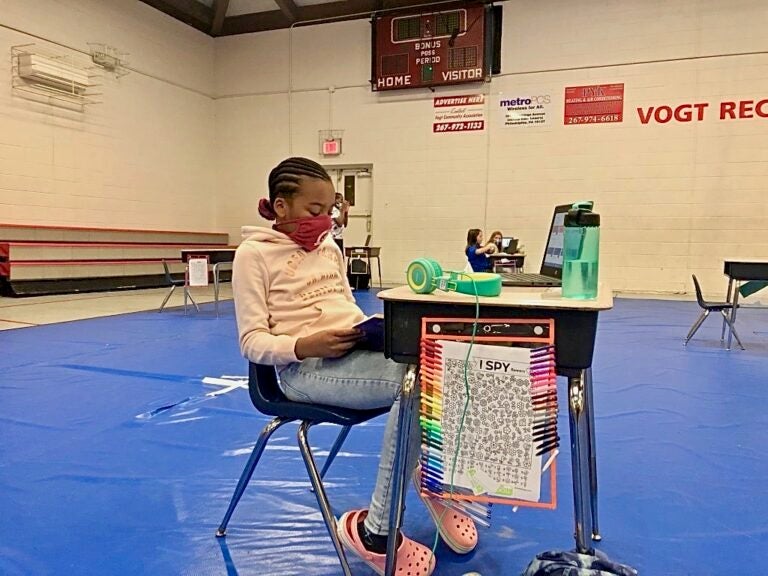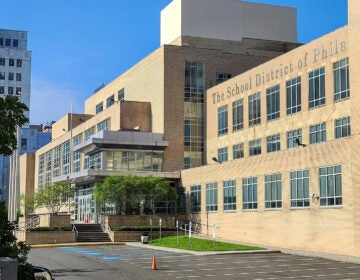Not all remote learning is created equal
With COVID numbers rising, more schools are going all remote But what your child has access to depends on what you have time for and how much is in your wallet.
Listen 16:37
Faith Allen, 10, reads at her desk in Vogt access center gymnasium. (Emily Rizzo/WHYY)
In this pandemic, every student is in a different situation. Some schools have kept in-person classes, while others have used a hybrid virtual model. Some districts, including Philadelphia, have taken a look at rising COVID numbers and decided to stay fully online at least through winter break.
Education advocates worry about the effects of virtual learning, especially on socialization and early literacy. But what your child has access to depends on where you live, what you have time for, and how much money is in your wallet. Keystone Crossroads reporters Miles Bryan and Emily Rizzo have been spending time with families across the economic spectrum who have been striving to help their kids get the most out of remote learning. They say parents have been doing everything from creating learning pods lead by private tutors to utilizing city-provided programs housed in recreation centers — all evidence the pandemic is further exposing the opportunity gaps between rich and poor students that have long existed.

Hear the whole story on The Why
Interview highlights
On what learning pods can look like
MILES: Pods come in a lot of shapes and sizes, but they generally refer to families that are friends with each other, or groups of parents, kind of getting together and bringing their kids together to replicate an in-person learning environment outside of school: at a home or maybe at some kind of third space. The cost of having a pod can run the gamut from free, if parents are just taking turns watching the kids, to a lot of money, if they hire a private tutor — which is a popular option for for parents with more means. I reported on one pod that had hired a private tutor for a group of about six kids that cost eighty dollars an hour.
On what it’s like in an access center, a city provided facility
EMILY: They’re doing their best to emulate a classroom …. I spent most of my time at Vogt Recreation Center in Tacony …. and there was really interesting. So there were two rooms that were makeshift classrooms. One was a huge gymnasium with 22 kids inside. The other one was more like a classroom with 22 kids inside. And their desks are six feet apart. It’s an echoey space. And you have three to four staffers walking around assisting the students with their school, work with any technical problems they’re having, whatever.
There’s kids from eight different schools, so they’re on eight different schedules. You have some kids eating lunch. One kid was waving his sandwich around in the air as other students around him were in class trying to focus.
And all the kids are wearing masks, but they’re sliding down their faces constantly. So a regular thing that you’d hear while walking through the rec center is “Mask on!” from the staffers. It’s constant. They’re constantly asking students to pull their masks up.
On the inequity different remote learning situations is perpetuating
MILES: I think the story that Emily and I are talking through about pandemic pods and other sort of options during this time of virtual learning comes down to the gap in wealth. A lot of parents don’t have the resources to help their kids. And so I think you’re just going to see that gap continue to grow. I don’t think this is a new story. I think this is the story of education.
EMILY: I completely agree with Miles, but I do think it’s complicated. I think parents — working parents, single parents — are doing the best that they can for their kids. They’re making the best choice out of not many options. I think a lot of parents that I spoke to feel that this is a reliable, more safe option than other choices they have. But I do think in the end that these kids at access centers are facing difficulties that maybe the kids that Miles encountered aren’t facing. So it does widen some of these inequalities.
MILES: When I started reporting this story, it was September. And part of the context was that soon, within a couple of weeks or maybe a month, a lot of the kids I talked to were scheduled to return to the classroom in some way, whether that was hybrid or full time. That was part of the context of the story: that maybe this wasn’t going to last …. And now Philadelphia has delayed its plan to return some young kids to the classroom for a few days a week. Montgomery County just announced it was going all virtual starting November 23 for at least two weeks. So, you know, these these temporary, makeshift, thrown-together solutions that we’ve all been thinking about as just a week or two or three out, seem like they’re settling in, like this is what kids and families are going to be working with for the indefinite future. So the inequities, the differences and the gaps in resources, the gaps in time and attention, those seem like they’re increasingly here to stay.
 WHYY is one of over 20 news organizations producing Broke in Philly, a collaborative reporting project on solutions to poverty and the city’s push towards economic justice. Follow us at @BrokeInPhilly.
WHYY is one of over 20 news organizations producing Broke in Philly, a collaborative reporting project on solutions to poverty and the city’s push towards economic justice. Follow us at @BrokeInPhilly.
WHYY is your source for fact-based, in-depth journalism and information. As a nonprofit organization, we rely on financial support from readers like you. Please give today.






